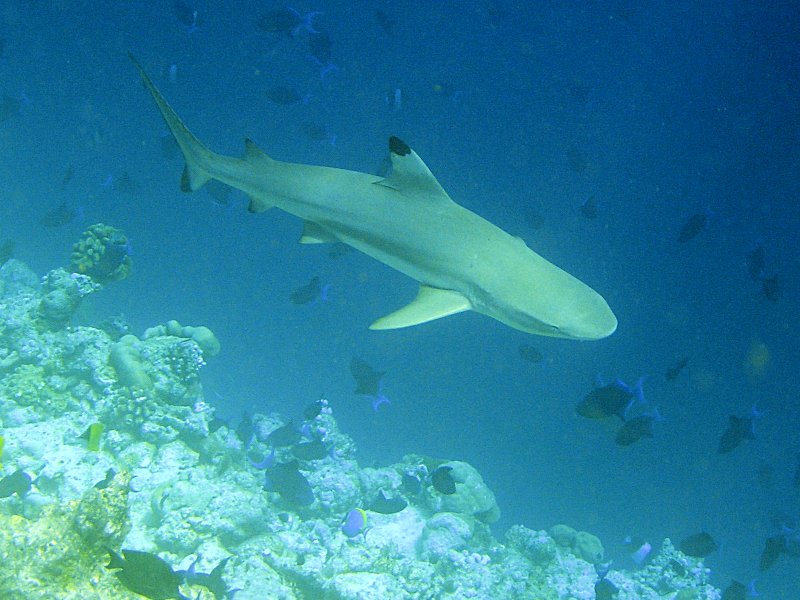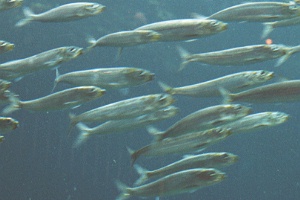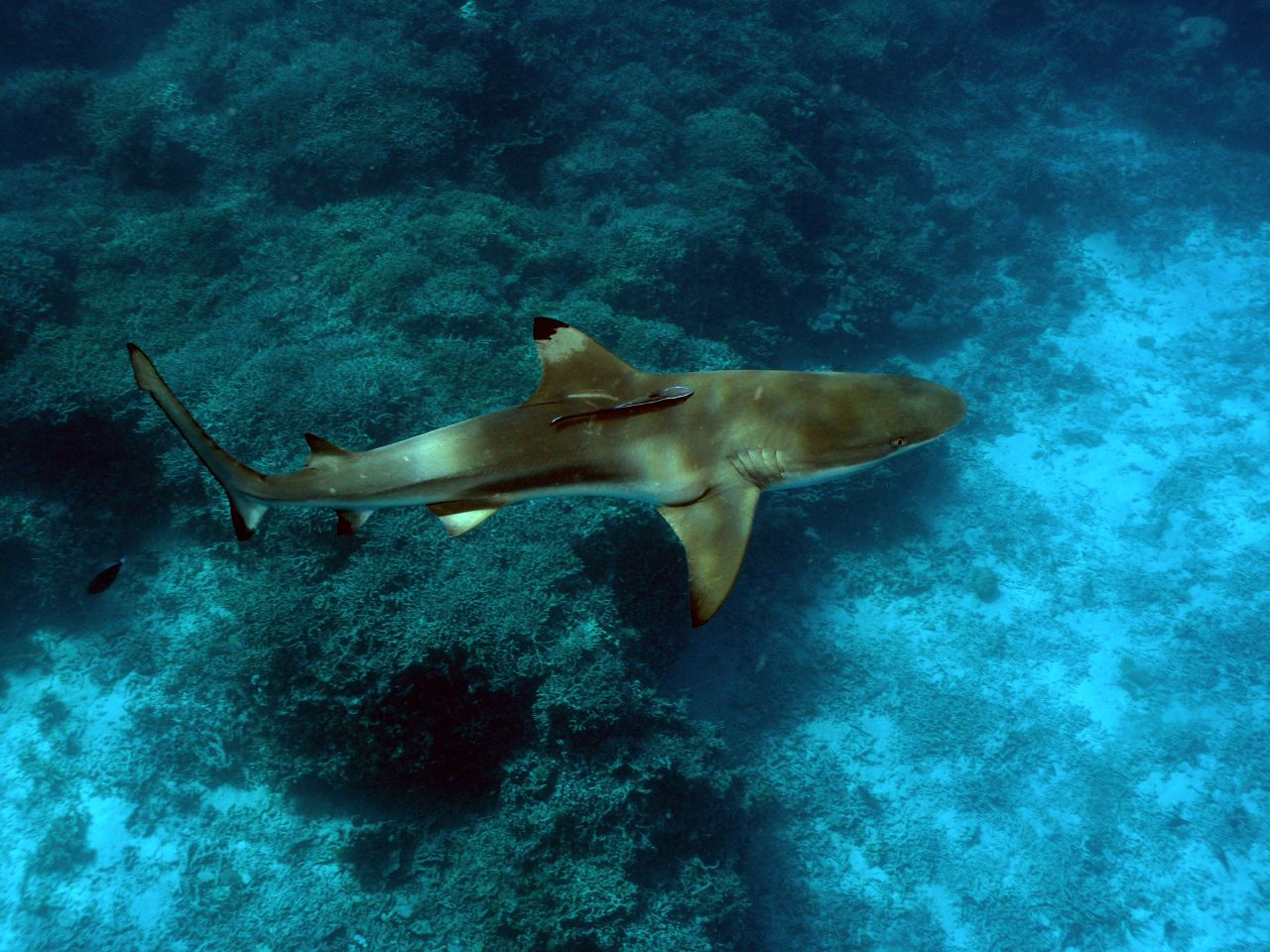|
Requiem Shark
Requiem sharks are sharks of the family Carcharhinidae in the order Carcharhiniformes. They are migratory, live-bearing sharks of warm seas (sometimes of brackish or fresh water) and include such species as the tiger shark, bull shark, lemon shark, spinner shark, blacknose shark, blacktip shark, grey reef shark, blacktip reef shark, silky shark, dusky shark, blue shark, copper shark, oceanic whitetip shark, and whitetip reef shark. Family members have the usual carcharhiniform characteristics. Their eyes are round, and one or two gill slits fall over the pectoral fin base. Most species are viviparous, the young being born fully developed. They vary widely in size, from as small as adult length in the Australian sharpnose shark, up to adult length in the tiger shark.Compagno, L.J.VFamily Carcharhinidae - Requiem sharksin Froese, R. and D. Pauly. Editors. 2010FishBase World Wide Web electronic publication, version (10/2013). Scientists assume that size and shape of thei ... [...More Info...] [...Related Items...] OR: [Wikipedia] [Google] [Baidu] |
Tiger Shark
The tiger shark (''Galeocerdo cuvier'') is a species of requiem shark and the last extant member of the family Galeocerdonidae. It is a large macropredator, capable of attaining a length over . Populations are found in many tropical and temperate waters, especially around central Pacific islands. Its name derives from the dark stripes down its body, which resemble a tiger's pattern, but fade as the shark matures. The tiger shark is a solitary, mostly nocturnal hunter. It is notable for having the widest food spectrum of all sharks, with a range of prey that includes crustaceans, fish, seals, birds, squid, turtles, sea snakes, dolphins, and even other smaller sharks. It also has a reputation as a "garbage eater", consuming a variety of inedible, man-made objects that linger in its stomach. Though apex predators, tiger sharks are sometimes taken as prey by groups of killer whales. It is considered a near threatened species because of finning and fishing by humans. The ... [...More Info...] [...Related Items...] OR: [Wikipedia] [Google] [Baidu] |
Spinner Shark
The spinner shark (''Carcharhinus brevipinna'') is a species of requiem shark, in the family Carcharhinidae, named for the spinning leaps it makes as a part of its feeding strategy. This species occurs in tropical and warm temperate waters worldwide, except for in the eastern Pacific Ocean. It is found from coastal to offshore habitats to a depth of , though it prefers shallow water. The spinner shark resembles a larger version of the blacktip shark (''C. limbatus''), with a slender body, long snout, and black-marked fins. This species can be distinguished from the blacktip shark by the first dorsal fin, which has a different shape and is placed further back, and by the black tip on the anal fin (in adults only). It attains a maximum length of . Spinner sharks are swift and gregarious predators that feed on a wide variety of small bony fishes and cephalopods. When feeding on schools of forage fish, they speed vertically through the school while spinning on their axis, erupting fro ... [...More Info...] [...Related Items...] OR: [Wikipedia] [Google] [Baidu] |
Viviparous
Among animals, viviparity is development of the embryo inside the body of the parent. This is opposed to oviparity which is a reproductive mode in which females lay developing eggs that complete their development and hatch externally from the mother. The term 'viviparity' and its adjective form 'viviparous' derive from the Latin ''vivus'' meaning "living" and ''pario'' meaning "give birth to". Reproductive mode Five modes of reproduction have been differentiated in animals based on relations between zygote and parents. The five include two nonviviparous modes: ovuliparity, with external fertilisation, and oviparity, with internal fertilisation. In the latter, the female lays zygotes as eggs with a large yolk; this occurs in all birds, most reptiles, and some fishes. These modes are distinguished from viviparity, which covers all the modes that result in live birth: *Histotrophic viviparity: the zygotes develop in the female's oviducts, but find their nutrients by oopha ... [...More Info...] [...Related Items...] OR: [Wikipedia] [Google] [Baidu] |
Pectoral Fin
Fins are distinctive anatomical features composed of bony spines or rays protruding from the body of a fish. They are covered with skin and joined together either in a webbed fashion, as seen in most bony fish, or similar to a flipper, as seen in sharks. Apart from the tail or caudal fin, fish fins have no direct connection with the spine and are supported only by muscles. Their principal function is to help the fish swim. Fins located in different places on the fish serve different purposes such as moving forward, turning, keeping an upright position or stopping. Most fish use fins when swimming, flying fish use pectoral fins for gliding, and frogfish use them for crawling. Fins can also be used for other purposes; male sharks and mosquitofish use a modified fin to deliver sperm, thresher sharks use their caudal fin to stun prey, reef stonefish have spines in their dorsal fins that inject venom, anglerfish use the first spine of their dorsal fin like a fishing rod ... [...More Info...] [...Related Items...] OR: [Wikipedia] [Google] [Baidu] |
Gill
A gill () is a respiratory organ that many aquatic organisms use to extract dissolved oxygen from water and to excrete carbon dioxide. The gills of some species, such as hermit crabs, have adapted to allow respiration on land provided they are kept moist. The microscopic structure of a gill presents a large surface area to the external environment. Branchia (pl. branchiae) is the zoologists' name for gills (from Ancient Greek ). With the exception of some aquatic insects, the filaments and lamellae (folds) contain blood or coelomic fluid, from which gases are exchanged through the thin walls. The blood carries oxygen to other parts of the body. Carbon dioxide passes from the blood through the thin gill tissue into the water. Gills or gill-like organs, located in different parts of the body, are found in various groups of aquatic animals, including mollusks, crustaceans, insects, fish, and amphibians. Semiterrestrial marine animals such as crabs and mudskippers have gill ch ... [...More Info...] [...Related Items...] OR: [Wikipedia] [Google] [Baidu] |
Whitetip Reef Shark
The whitetip reef shark (''Triaenodon obesus'') is a species of requiem shark, in the family Carcharhinidae, and the only member of its genus. A small shark that does not usually exceed in length, this species is easily recognizable by its slender body and short but broad head, as well as tubular skin flaps beside the nostrils, oval eyes with vertical pupils, and white-tipped dorsal and caudal fins. One of the most common sharks found on Indo-Pacific coral reefs, the whitetip reef shark occurs as far west as South Africa and as far east as Central America. It is typically found on or near the bottom in clear water, at a depth of . During the day, whitetip reef sharks spend much of their time resting inside caves. Unlike other requiem sharks, which rely on ram ventilation and must constantly swim to breathe, this shark can pump water over its gills and lie still on the bottom. At night, whitetip reef sharks emerge to hunt bony fishes, crustaceans, and octopus in groups, their e ... [...More Info...] [...Related Items...] OR: [Wikipedia] [Google] [Baidu] |
Oceanic Whitetip Shark
The oceanic whitetip shark (''Carcharhinus longimanus''), also known as shipwreck shark, Brown Milbert's sand bar shark, brown shark, lesser white shark, nigano shark, oceanic white-tipped whaler, and silvertip shark, is a large pelagic requiem shark inhabiting tropical and warm temperate seas. Its stocky body is most notable for its long, white-tipped, rounded fins. Though slow-moving, it is opportunistic and aggressive, and is reputed to be dangerous to shipwreck survivors. Recent studies show steeply declining populations because its large fins are highly valued as the chief ingredient of shark fin soup, and as with other shark species, the whitetip faces mounting fishing pressure throughout its range. Taxonomy The oceanic whitetip shark, or lesser white shark, was described in 1831 by naturalist René-Primevère Lesson, who named the shark ''Carcharhinus maou''. It was next described by Cuban Felipe Poey in 1861 as ''Squalus longimanus''. The name ''Pterolamiops longimanu ... [...More Info...] [...Related Items...] OR: [Wikipedia] [Google] [Baidu] |
Copper Shark
The copper shark (''Carcharhinus brachyurus''), bronze whaler, or narrowtooth shark, is a species of requiem shark, family Carcharhinidae, and the only member of its genus found mostly at temperate latitudes. It is distributed in a number of separate populations in the northeastern and southwestern Atlantic, off southern Africa, in the northwestern and eastern Pacific, and around Australia and New Zealand, with scattered reports from equatorial regions. This species can be found from brackish rivers and estuaries, to shallow bays and harbors, to offshore waters deep or more. Females are found apart from males for most of the year, and conduct seasonal migrations. A large species reaching long, the copper shark is difficult to distinguish from other large requiem sharks. It is characterized by its narrow, hook-shaped upper teeth, lack of a prominent ridge between the dorsal fins, and plain bronze coloration. Feeding mainly on cephalopods, bony fishes, and other cartilaginous ... [...More Info...] [...Related Items...] OR: [Wikipedia] [Google] [Baidu] |
Blue Shark
The blue shark (''Prionace glauca''), also known as the great blue shark, is a species of requiem shark, in the family Carcharhinidae, which inhabits deep waters in the world's temperate and tropical oceans. Averaging around and preferring cooler waters, the blue shark migrates long distances, such as from New England to South America. It is listed as Near Threatened by the IUCN. Although generally lethargic, they can move very quickly. Blue sharks are viviparous and are noted for large litters of 25 to over 100 pups. They feed primarily on small fish and squid, although they can take larger prey. Maximum lifespan is still unknown, but it is believed that they can live up to 20 years. Anatomy and appearance Blue sharks are light-bodied with long pectoral fins. Like many other sharks, blue sharks are countershaded: the top of the body is deep blue, lighter on the sides, and the underside is white. The male blue shark commonly grows to at maturity, whereas the larger fema ... [...More Info...] [...Related Items...] OR: [Wikipedia] [Google] [Baidu] |
Silky Shark
The silky shark (''Carcharhinus falciformis''), also known by numerous names such as blackspot shark, gray whaler shark, olive shark, ridgeback shark, sickle shark, sickle-shaped shark and sickle silk shark, is a species of requiem shark, in the family Carcharhinidae, named for the smooth texture of its skin. It is one of the most abundant sharks in the pelagic zone, and can be found around the world in tropical waters. Highly mobile and migratory, this shark is most often found over the edge of the continental shelf down to . The silky shark has a slender, streamlined body and typically grows to a length of . It can be distinguished from other large requiem sharks by its relatively small first dorsal fin with a curving rear margin, its tiny second dorsal fin with a long free rear tip, and its long, sickle-shaped pectoral fins. It is a deep, metallic bronze-gray above and white below. With prey often scarce in its oceanic environment, the silky shark is a swift, inquisitive, an ... [...More Info...] [...Related Items...] OR: [Wikipedia] [Google] [Baidu] |
Blacktip Reef Shark
The blacktip reef shark (''Carcharhinus melanopterus'') is a species of requiem shark, in the family Carcharhinidae, which can be easily identified by the prominent black tips on its fins (especially on the first dorsal fin and its caudal fin). Among the most abundant sharks inhabiting the tropical coral reefs of the Indian and Pacific Oceans, this species prefers shallow, inshore waters. Its exposed first dorsal fin is a common sight in the region. The blacktip reef shark is usually found over reef ledges and sandy flats, though it has also been known to enter brackish and freshwater environments. It typically attains a length of . The blacktip reef shark has extremely small home ranges and exhibits strong site fidelity, remaining within the same local area for up to several years at a time. It is an active predator of small bony fishes, cephalopods, and crustaceans, and has also been known to feed on sea snakes and seabirds. Accounts of the blacktip reef shark's life history ... [...More Info...] [...Related Items...] OR: [Wikipedia] [Google] [Baidu] |



.png)





